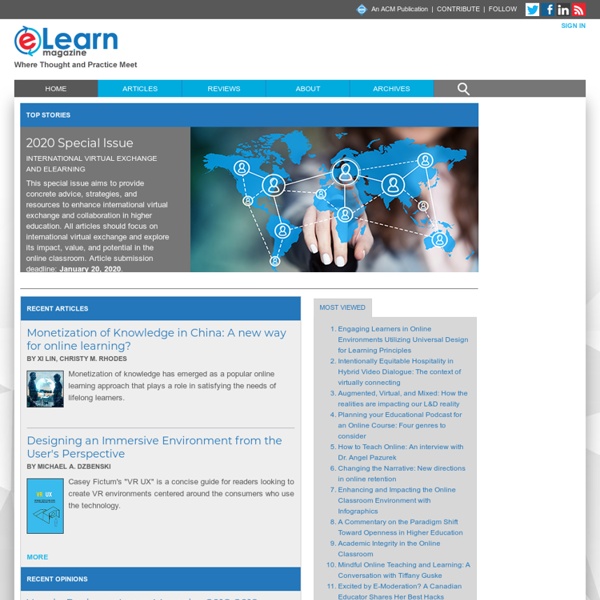



http://elearnmag.acm.org/index.cfm
Related: Online Learningfacilitating learning and change in groups and group sessions Facilitating learning and change in groups and group sessions. Just what is facilitation, and what does it involve? We explore the theory and practice of facilitation, and some key issues around facilitating group sessions. A new (home)school year begins: A month ago, I was feeling kind of stuck for blog post ideas, so I threw it out there to Twitter and Facebook — what would guys like to hear about? — and, to my surprise, someone asked me about homeschooling my kid. Huh. I admit, I don’t post much about my kid because, to be frank, I hate to see bloggers use their kid’s life as fodder for posts. My kid is a person who has a right to privacy — to not have her life broadcast for the cheap entertainment of others — the same as anyone. But, at the same time, I really see homeschooling as going hand-in-hand with my ideas about voluntary simplicity, and since I was asked, I’m breaking my vow of not making posts about my kid (although I asked her first it she would mind and she was all “sure, whatevs” about it).
Instructional Design Models The following is a list of prescriptive instructional design models. Prescriptive models provide guidelines or frameworks to organize and structure the process of creating instructional activities. These models can be used to guide your approach to the art or science (your choice) of instructional design. Open Source Integrations BigBlueButton has been integrated into other Open Source Projects. Moodle The Moodle activity module allows you to easily create, manage and join BigBlueButton meetings from within Moodle. The BigBlueButtonBN integration supports record and playback of sessions for Moodle 1.9 and 2.x. Learn More
Revisiting Multiliteracies in Collaborative Learning Environments: Impact on Teacher Professional Development September 2006 — Volume 10, Number 2 * On the Internet * By Vance Stevens Petroleum Institute, Abu Dhabi, UAE Editor’s foreword: At this time last year I wrote an article for the On the Internet column, “Multiliteracies for Collaborative Learning Environments”. (Stevens 2005; As indicated in the editor’s note at the foot of that article, it was prepared partly as a rough guide for the participants in my TESOL, Inc. Certificate Program course of the same name [ which completes its third rendition this October. Face-to-face or Online? November 14, 2011 by Brian Chanen · 1 Comment · Brian Chanen, Online/Blended Learning, Others When, like Jason, I think of the most meaningful educational experiences I have had, I remember a number of moments from working through a difficult novel to the time I finally realized that if you throw a Rubik’s cube really hard against a wall it will break into colorful mini-cubes. If I’m serious about trying to envision important moments of learning, though, I also tend to remember people—the teachers who helped me or the friends who took classes with me. I often consider myself lucky to be at a school that is small enough for teachers and students to work closely together and dedicated enough to invest heavily in a face-to-face, brick-and-mortar expansion into a new building.
A step-by-step guide for making online classes accessible Montana State University professors discuss a 10-step plan to applying Universal Design for Learning in online courses. According to professors at Montana State University (MSU), incorporating Universal Design for Learning (UDL) in online courses not only benefits students with disabilities, but can have significant benefits for all students, ultimately increasing retention and improving learning outcomes—but how to implement? The implementation guidelines are part of a recent report written by Dr. Cindy Ann Dell, assistant professor, Educational Theory and Practice at MSU; Thomas Dell, assistant professor, Rehabilitation and Human Services at MSU; and Dr. Terry Blackwell, professor and chairperson, Rehabilitation and Human Services at MSU; which aims to help other professors and curricular specialists in online learning implement UDL for teaching both general and diverse populations, including students with disabilities. Knowing Where to Start
A Peek Inside Summit’s Personalized Learning Software Over the last three years, Summit Public Schools, a network of charter public high schools in northern California, has made a radical shift from a traditional high school model to an innovative, competency-based learning model. In this new model, students are responsible for independently mastering basic content, freeing up teachers to spend class time on projects and other tasks that promote deeper learning. Summit’s push to reimagine its programs was based on four core ideas:
Visual Thinking In eLearning: What eLearning Professionals Should Know How can eLearning professionals create eLearning courses that appeal to our visual nature while still including all of the key subject matter? In this article, I’ll explore the basics, benefits, and uses of visual thinking in eLearning. Visual thinking refers to a learning approach that links complex ideas or concepts to visual elements, such as images, word maps, or infographics.
Learners’ Interpersonal Beliefs and Generated Feedback in an Online Role-Playing Peer- Feedback Activity: An Exploratory Study Volume 17, Number 2 February - 2016 Yu-Hui Ching and Yu-Chang Hsu Boise State University, USA Peer feedback affords interaction and critical thinking opportunities for learners in online courses. However, various factors prevent learners from taking advantage of these promising benefits.